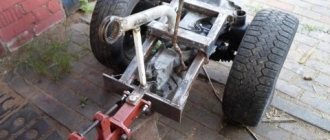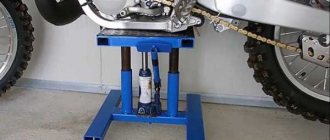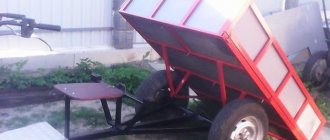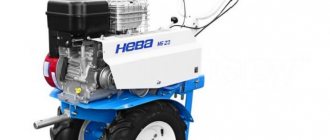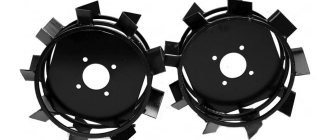What it is?
An adapter for a walk-behind tractor is a trolley, the main elements of which are a seat, a brake, a brake handle, footrests, a coupling mechanism and a frame with structural parts attached to it.
The brake of the device is located near the footrest. Typically, such a device is equipped with two wheels, and the seat often has a lifting lever. The design of the adapter can be either universal or special: some of these varieties provide for additional fastening of various canopies.
Equipping the walk-behind tractor with an adapter practically turns the working unit into a mini-tractor with a seat that increases operator comfort.
What is an adapter and what is it used for?
The adapter is a special module that allows you to convert a walk-behind tractor into a full-fledged mini-tractor with a comfortable chair. Most often, this design is installed on powerful equipment running on gasoline or diesel.
Many people are interested in why exactly other owners decide to install an additional adapter on their unit. Most often this is done to slightly expand the functionality of the walk-behind tractor.
Adapters - devices that allow you to expand the functionality of walk-behind tractors
If you install such a module on a cultivator, using a walk-behind tractor you can:
- clean up mown hay;
- level the ground surface;
- plow the ground;
- transport large cargo.
Installing the adapter will allow you to modernize the walk-behind tractor in the future. For example, you can install a canopy on it to protect from the sun or rain.
Application area
If we consider in general the purpose of adapters for walk-behind tractors, then their purpose is to relieve the user and make his hard work easier. Depending on what type of auxiliary equipment is attached to the walk-behind tractor, its scope of use can expand significantly.
For example, in addition to plowing, weeding, hilling and harvesting root crops, it will be possible to remove hay, clear some types of surfaces from snow, and level the soil surface. In addition, it will be possible to transport oversized cargo.
Tips and recommendations when choosing a trailer for a walk-behind tractor
When choosing, you should remember where and how often you plan to use the adapter, and what walk-behind tractor it will be connected to. So for large areas where there is a lot of work to be done, you need a model with folding sides and a tipper function. Shipment and loading will be much faster.
Trailer with drop sides and tipper function
The size of the future purchase depends not only on the volume of planned work, but also on the walk-behind tractor itself, or more precisely, its potential. If it has a maximum towing capacity of 300 kg, a large cart will be useless.
Important! If you plan to transport a load of 350 kg or more, mechanical brakes are required. Hubs also matter—it’s better to choose steel ones.
When making any purchase, most Russians place the main emphasis on price, but it is also important to keep in mind the brand and the reputation of the manufacturer. The price for products from popular companies is usually higher, but it should be remembered that these are the trailers that can be combined with almost any walk-behind tractor - this is on the list of priorities of any self-respecting manufacturer.
What types of adapters for walk-behind tractors are there?
Externally, the adapter design is a small frame with two wheels, a platform for feet, a drawbar and a seat for the operator. By equipping a walk-behind tractor with such a “new thing”, you will actually turn it into a mini-tractor - working will become much more convenient, faster and easier, and the ability to adjust the seat will make the work process more comfortable.
There are several types of adapters for walk-behind tractors. In order to buy or make the most suitable option for you, you should familiarize yourself with all types of this equipment.
Based on the type of clutch, adapters are divided into adapters with steering and movable joints. Depending on the location - on the front adapters and rear ones.
Adapters can also be classified into a separate classification based on the purpose of use: with an extended drawbar for powerful large walk-behind tractors, with a shortened drawbar for small, lightweight units.
Adapter with steering
This type is on a rigid joint with a walk-behind tractor. The steering is represented by a separate unit, and options with both rear and front wheels are possible.
The walk-behind tractor becomes practically a self-propelled machine, which is quite simple and easy to operate, practically no different from motorcycles or cars.
Features of the adapter for walk-behind tractor
An adapter is a special device for riding a walk-behind tractor. Using it, you can simultaneously drive a walk-behind tractor and cultivate the soil.
An adapter for a walk-behind tractor will help turn it into a mini-tractor
Working with a walk-behind tractor will be greatly simplified if you use an adapter. You will be able to change attachments, depending on what work you need to do - hilling, planting, weeding, transportation. With the help of this device, all processes will be doubled.
This unit allows you to sit comfortably on the seat with which it is equipped. Now you can do household chores, but with more comfort. Steering adapters are available on the market. However, you can make them yourself.
Design and principle of operation
Essentially, the adapter is presented in the form of a trolley that is attached to the walk-behind tractor. After which the structure turns into a mini-tractor. The main details of such a unit:
- a frame to which other constituent elements are attached;
- driver's seat with lift lever;
- 2 wheels;
- clutch device;
- wheel axle.
In this video we will analyze the front adapter:
Frame
It is one of the most important elements of the device, since other elements are connected to it. Therefore, it must be made of high-quality and durable materials.
Driver's seat
One of the main advantages of the adapter is a comfortable seat for the operator.
Wheels
There are 2 types of wheels available - metal and rubber. The former are used for heavy types of work in the field. The latter are designed for driving on dirt roads.
Clutch device
The hitch is responsible for connecting the attachments and the mechanical unit itself. This fastening is defined as one of the most important, therefore it is made of high-strength metals - steel or cast iron.
See also: Strapping machines: review article
The length of such a device is about 2 meters, width – 80 centimeters.
Depending on the clutch, the following design options can be considered:
- with movable clutch. This device is the lightest. The clutch here is located in the front, but control in this case is more difficult, since it is necessary to deploy the entire power unit;
- with steering. The clutch here is rigid, and control is achieved through a mechanical steering unit. This control is easier to use, but more difficult to produce.
There are different adapters for walk-behind tractors of different performance. For mechanisms with low power - with a short mount, for powerful ones - with a long one.
Pros and cons of a front adapter
The unit is located in front of the walk-behind tractor using 3 screws. The maximum width of the device reaches 80 cm, length – 225 cm, and the height of the seat is no more than 71 cm. Its turning radius is smaller than the previous type and is 220 cm.
The unit is controlled by using the gas and brake pedals. At arm's length there is a handle with which you can easily change gears.
It should be noted that the maneuverability of this mechanism is inferior to that of the rear adapter . Overcoming obstacles becomes more difficult if there is cargo in the back. Load capacity is 2 times lower.
The presence of a free hitch makes it possible to attach additional devices or attachments for processing soil or transporting cargo.
Advantages and disadvantages
Adaptive steering of a walk-behind tractor is convenient because:
- eliminates the need to walk behind motor vehicles;
- the traction potential of the walk-behind tractor is fully realized;
- the functionality of agricultural equipment increases;
- transportation of the unit to a specific processing area is simplified;
- easier control - no longer requires a lot of operator effort;
- the structure can be disassembled if necessary;
- sufficient balance is achieved on all axes.
The disadvantages include an increase in fuel consumption, which after modification takes one and a half times more. However, these losses are justified by the ease of management and saving a colossal amount of time that the gardener spends when working with the land.
Device
The trailer adapter for the walk-behind tractor is a two-wheeled transport trailer design. When installing more than two wheels, the load capacity increases, but the power remains the same. The operator's seat can be adapted. The design of the resulting device consists of:
- Frame – there is a ladder or spine type.
- Suspension – does not contain elastic parts. Can be rotary, bridge, axial type.
- Portal for additional accessories - available as part of the rear versions. The front types do not have it; a portal of a walk-behind mechanism is used.
- Hitch – connects the walk-behind tractor and the adapter. Characterized by reliability and stability.
- The workplace is designed for the driver’s safe stay. In some cases, it is possible to install a backup control system.
- Steering is possible when an adapter for a walk-behind tractor with a steering wheel is developed. Various design options are possible: take a ready-made steering wheel or make it yourself
The dimensions of the adapter for a do-it-yourself walk-behind tractor vary depending on the design.
Varieties
Adapters with steering can be classified according to the type of wheel arrangement. The steering gear is performed in the format of a separate unit. The steering wheels can be located at the front or rear.
As for the position of the steering gear, this depends on the design features and spare parts, because during operation it is impossible to avoid repairs and replacement of worn parts.
Models in which the adapter is located at the front are called front-steering varieties. In such modifications, the engine is a kind of tractor for the entire unit.
If the adapter is located at the rear, and the walk-behind tractor has to pull it behind it, such a device is called rear-wheel drive. In other words, if the adapter is located in front of the walk-behind tractor, it is a front-type product, and if at the back, it is a rear-type product.
The choice of one or another option is made by the buyer himself, based on his own preferences.
For example, the front version is more suitable for loosening and plowing the cultivated soil. Here, in addition to the power of motor vehicles, there is no need for an overview of the site. If you need to hill up the crop being grown, then the rear analogue is better suited for such purposes.
However, you can take a closer look at the option where the adapter is located closer to the drive axis. In this case, the operator’s weight will create additional load, preventing the walk-behind tractor from jumping out of the ground while the equipment is operating.
Based on the variety, adapters can be classified into body and bodyless. The former involve the transportation of goods, the latter are more suitable for cultivating the soil. Depending on the power of the unit, the adapters are connected to the walk-behind tractor using a long or short drawbar. The first modifications are used on heavy equipment, the second are used on light equipment.
Plowing with a walk-behind tractor with an adapter: instructions
The quality of plowing improves significantly if you do this together with an adapter. The functionality of the unit increases to the level of a tractor. The plowing process is easy but measured. For processing virgin soil, devices weighing over 100 kilograms are better suited.
Soil treatment occurs in several stages. It is best to process damp soil. It is important to change the direction in which plowing occurs every year.
Tags: section, bolts, trailer, weld, ready, seat, two, apparatus, needed, drawbar, necessary, option, drive, should, square, worth, welding, work, different, create, any, height, operation, bushings, legs, place, adblock, depends, gearbox, structurally, varieties, reliability, separate, further, front, hitch, take, reliably, general, bracket, labor, friend, provides, especially, differs, track, owner, first, main, must
How to install?
Let's look at the principle of installing an adapter with a steering wheel using the example of a model for a KTZ walk-behind tractor with a steering column. Connecting the adapter to the walk-behind tractor begins with installing the trailer on the pin of the walk-behind tractor, which is located in its front part. The knot is secured with a cotter pin.
After this, you need to move the gas to its place under the seat, carrying it with the original cable. To do this, use a 10mm wrench and a screwdriver, remove the throttle control lever, remove the top plug under the seat, and lay the cable. If necessary, change the bolt, since depending on the adapter model, it may be larger than necessary.
See also: Intimate hygiene gel: reviews and which one is better?
Next, tighten the bolts with a 10mm wrench. When moving the gas, make sure that the cable does not interfere anywhere. Remove the steering wheel from the walk-behind tractor and unhook the clutch and gearbox release cables.
Next, remove the steering wheel using a stand for ease of use. Having removed the steering wheel, remove the support and begin installing the pedals. At this stage of work, use a cable with an adapter plate, which is included with the adapter.
The plate is installed on the wing of the walk-behind tractor and secured with a bolt and nut. The lever screwed to the cable is placed in place of the roller bracket. After this, install the second cable, secure it and attach it to the installed bracket, fix it until the moment allows the cable to move.
Now you need to set the forward gear to the right pedal. There is no need to remove it for this. At the same time, adjust the components, checking the forward tension . After this, reverse is installed.
What to look for when choosing a trailer/adapter for a walk-behind tractor
When planning to purchase a trolley for a walk-behind tractor, consider:
- trailer category. Only a walk-behind trailer is suitable for a walk-behind tractor. A car is absolutely not suitable because it is not equipped with a brake system and an operator’s chair. Even if such a design can drive on a flat surface, and even then not without errors, it simply will not hold up on a slope. This is especially true for low-power walk-behind tractors;
- material. Galvanized and steel models are the most practical and durable, but they are also more expensive. Plastic ones are cheaper, but they will not last long and are only suitable for light loads;
- load capacity - this is indicated by the number in the model name.
Wheels are also of great importance - especially if the garden is located in a lowland, where the soil is viscous and has a high level of humidity. Most often, models with 4x10-inch wheels are purchased.
Video - What you need to know when choosing a walk-behind tractor and its trailer
Homemade adapter
An adapter for Neva walk-behind tractors can be purchased at an agricultural equipment store from. It is available on the market as the Neva APM 350 cultivator adapter for walk-behind tractors.
It is important to pay attention to the fact that it is also compatible with other agricultural equipment from this manufacturer. For example, the adapter can be used as a rotary adapter for a Neva motor-cultivator mower.
However, a homemade adapter helps save money. Moreover, it is much more pleasant to use and can be repaired at home at any time of the day.
There are several types of adapters to the Neva
Homemade adapters for Neva walk-behind tractors come in two types:
- Heavy, which, in turn, are divided into long and short.
- Lightweight (installed on cutters).
There are also front and rear devices, depending on the drive.
More detailed information regarding the drives is provided below.
Front
In the case of a front adapter for a walk-behind tractor with or without steering, the unit is placed behind the walk-behind tractor and is controlled in the same way as a motorcycle. This model is the most popular due to its ease of use.
This design is easy to use and easy to transport.
Rear
If you decide on an adapter for a rear-wheel drive Neva walk-behind tractor, you need to make it in front of the entire device.
This arrangement is very convenient for performing various types of work in the garden, when you cannot do without attachments from the back or front.
Full
This device also comes with all-wheel drive.
In this case, the unit can be located in front or behind. However, a significant difference in characteristics from the above-mentioned varieties is that four wheels are simultaneously involved in the work. This design is more reminiscent of a miniature tractor.
Important! This adapter drive is the most powerful, although not popular.
The most powerful adapter - complete
What does the adapter consist of?
People who have seriously decided to install such a module on their Neva walk-behind tractor must understand its design features. According to standard drawings, this device consists of the following components:
- Frame . This is the main part of the structure to which all other components are attached.
- Seat . The adapters are equipped with fairly large and comfortable chairs with a backrest.
- Wheels . They are attached to the bottom of the frame and are located under the seat.
- Coupling mechanism . It is with its help that the adapter is attached to the walk-behind tractor.
Most modules for cultivators are equipped with a comfortable seat.
Some types of designs are equipped with a special steering mechanism. With its help, a person will be able to independently regulate the direction of movement of the walk-behind tractor.
Many adapters have an additional hitch on the back. It is used to attach a trailer for transporting goods.
Recommendations for use
Regardless of the type of assembled and connected product, you need to start working with it by taking into account safety regulations. Before starting the engine, you need to conduct a visual inspection of the equipment to eliminate visible damage and malfunctions. Do not add fuel to the fuel tank while the engine is running.
If you hear an unusual noise when you turn it on, you need to stop the engine and identify the cause of the problem.
Do not use gasoline of inappropriate brands or fuel mixed with oil and other impurities. Before each start, you need to check the oil level, since this is often the reason the engine stops.
In order to extend the service life of motorcycles, a new product must be run-in. It will contribute to the trouble-free functioning of the walk-behind tractor.
During this process, the working surfaces of the parts are usually worked out. The duration of running-in, as a rule, varies for products of different brands and modifications. In some varieties it can be up to 20 hours or more. At this time, you should not load the equipment to the maximum extent.
See also: How to organize an office move
One recommendation is to change the oil after the first five hours of operation. As for warming up the engine, this should be done at medium speeds without load for about three minutes.
Based on the modification of the walk-behind tractor, for the first hours of its operation it is necessary to operate the unit in first gear (with the gas lever in the middle position). It is important to try to avoid not only maximum, but also minimum speed . At the end of using the equipment, you need to check the tightness of the threaded connections.
As for the cultivated soil, it is better to cultivate simple soil in the first hours. In addition, you need to take into account that rolling in is not done on rocky and clay soil.
Before work, you need to inspect the area and remove stones and large debris. In general, when working with motorized equipment, you need to constantly monitor its cleanliness and check the fastening strength of the accessible elements of the adapter and walk-behind tractor, including attachments.
Don't forget to tighten any loose fasteners. You also need to remember about timely maintenance.
About the device
In terms of its design, the 4x4 adapter intended for the Neva walk-behind tractor is a fairly simple device. It consists of several main components:
- frame structure on which other components are installed;
- driver's seat;
- wheelbase, as well as wheel axle;
- mechanism for connecting the adapter and walk-behind tractor.
Simply put, the adapter is a regular cart with a seat that is attached to a walk-behind tractor. Walk-behind tractors can be such as Cayman, Patriot, Texas, Foreman, Crosser, Viking, Loplosh (loplosh video) and others. After coupling the adapter and walk-behind tractor, it can be compared in functionality to a mini tractor, but such a comparison is a little arbitrary, because the power remains the same, i.e. from the walk-behind tractor engine.
In addition, additional attachments can be attached to the adapter, which further expands the potential scope of work.
Some adapters are equipped with special compartments where you can place some kind of cargo. There are models equipped with a lifting lever, which greatly simplifies working with the device.
As a rule, the adapter contains two couplings - one allows you to attach it to a walk-behind tractor, and the second allows you to attach additional attachments. In particular, you can connect a seeder, hillers, plow, harrow and other devices to the adapter.
The wheelset axle in the adapter is of a fairly robust design, allowing the walk-behind tractor to be used on the most difficult areas of land, as well as for transporting fairly heavy loads.
It is also important to understand that driving such a unit on public roads is prohibited, which is why they are used exclusively in rural areas.
However, despite some structural similarity between all adapters, they also have some differences. In particular, rear adapters with steering, front adapters and all-wheel drive units are available for sale.
For more details about the adapter for the Neva walk-behind tractor, watch the video:
Maintenance and storage
As a rule, you need to check the oil level every time you turn it on, and replace it at least once every six months. The air filters are checked before turning on the unit. Clean it when it gets dirty or once every three months.
The sump tank is cleaned every six months. If it is necessary to replace consumables, they try to buy original parts or those with similar quality characteristics.
They will help extend the life of agricultural equipment and will not cause engine failure. As for cleaning the air filter, this is necessary to maintain the working condition of the carburetor.
Do not use a solvent with a low flash point for this, as this is flammable and can lead not only to a fire, but also to an explosion. You cannot use equipment without an air filter, because this causes accelerated engine wear.
Repairs are carried out in a well-ventilated area with the engine turned off. In this case, it is necessary to ensure a sufficient level of ventilation in the work area. Exhaust gases are hazardous to human health and inhalation can be fatal. Motor vehicles should be stored in a dry, ventilated area .
During the summer season, it is not recommended to leave it outside, especially if the base of the operator’s seat is made not of plastic, but of wood. In order to extend the quality and performance characteristics, when storing the unit outdoors, you need to cover it with a tarpaulin cover.
If you do not plan to use agricultural machinery for more than three months, gasoline is poured out of the fuel tank, it is cleaned, and the position of the gas lever is checked. If necessary, disconnect the wheels.
Sources
- https://stroy-podskazka.ru/motobloki/adapter/
- https://sadovaja-tehnika.com/motobloki/navesnoe-oborudovanie/adapter/
- https://MoyMotoblok.ru/navesnoe-oborudovanie/samodelnyj-adapter-dlya-motobloka-svoimi-rukami-chertezhi/
- https://vsemotobloki.com/navesnoe-oborudovanie/dlja-svoimi-rukami.html
- https://stroy-podskazka.ru/motobloki/adaptery-s-rulevym-upravleniem/
- https://vsemotobloki.com/motobloki/neva/adapter-na-motoblok-neva.html
Did the article help you?
Andrey
Ask questions
Ask questions and write answers in the comments
How to make your own all-wheel drive adapter for the Neva walk-behind tractor
Of course, purchasing a ready-made adapter for the Neva walk-behind tractor is the simplest and best way out of the situation. However, they cost quite a lot, so not every summer resident or farmer can afford to purchase them. It is not surprising that many people ask the question - how to make an adapter for the Neva walk-behind tractor?
There are quite a lot of recommendations on the network regarding the manufacture of adapters, as well as many drawings that allow you to see this device in more detail. Using them, it is quite possible to make such a unit at home, using the bare minimum of materials and tools.
What you need to make a homemade adapter
To make a homemade adapter we will need:
- pair of wheels;
- steel angles, iron sheets and pipes;
- driver's seat;
- welding machine;
- fastening connections, etc.
A do-it-yourself adapter for the Neva walk-behind tractor, drawings of which will be presented later, can be made using this minimal list. Before proceeding directly to the manufacture of the device, you need to draw its diagram.
It should provide for the degree of load of different parts of the frame, as well as the overall dimensions of the device. You can do this yourself, or you can use the drawings of those who have already successfully assembled a homemade adapter.
Let's move on to manufacturing the structure. Let's divide all the work into several main steps:
- We will need a square metal profile , the length of which should be approximately 1800 mm. Across this profile you need to weld such a piece, but of a smaller size - about 600 mm. The wheel stands will be attached to this piece of profile.
- The height of the racks should be about 300 mm.
- Next you need to weld the braces. They are welded to the main frame, as well as to the wheel hubs. The angle of their location relative to the frame can be made at any angle at your discretion.
- Additionally, we weld a beam to the metal profile. This is needed to strengthen the frame.
- The frame structure for the attachments is welded from channel number 10. It is connected to the wheel axle with a piece of square pipe, and the seams are welded.
- Next, we weld a control lever with three bends to the frame. Accordingly, these are 350, 550 and 200 mm. We attach to this lever another one measuring 800 mm, which will regulate the force. The levers are connected to each other with ordinary bolts.
- We weld a piece of pipe approximately 300 mm long to the main frame - this will be our seat stand. At the top we also weld two pieces of pipe perpendicular to this stand. This is necessary so that the seat is more stable and does not come off during operation.
- The seat can be taken ready-made , or made from a piece of plywood, then covered with foam rubber or other soft material. The seat is attached to transverse pieces of pipe welded to the stand under the seat, as well as to the stand itself. We use regular bolts as fasteners.
- At the front you need to weld the coupling mechanism to the walk-behind tractor.
As we can see, the work is quite simple, but you will need skill in working with a welding machine, because... There is no other method of connecting all the components.
You can complicate the design a little by making a homemade adapter for the Neva walk-behind tractor, which will have steering control . For this we need:
- iron sheets;
- steel pipes and angles;
- seat;
- a pair of wheels;
- welding machine.
In this case, the adapter frame must be well articulated with the walk-behind tractor so that the structure does not move to the sides. As a steering wheel, you can take a ready-made one from old Soviet cars (for example, from a VAZ).


